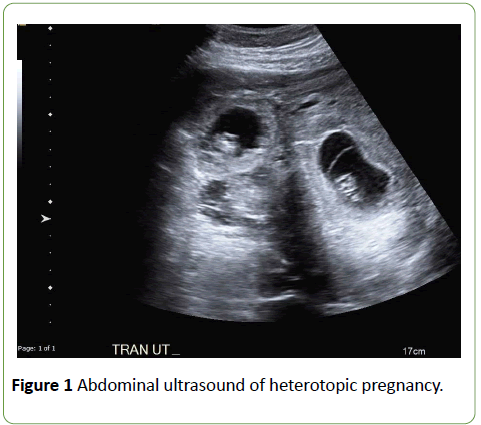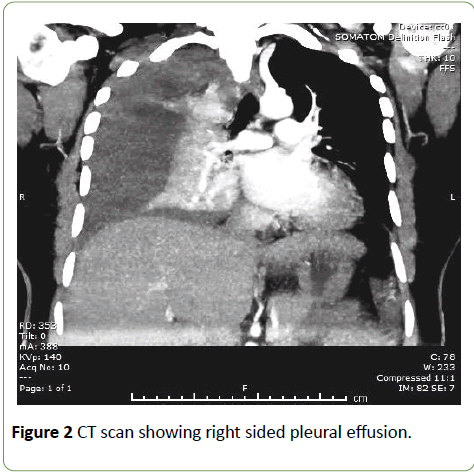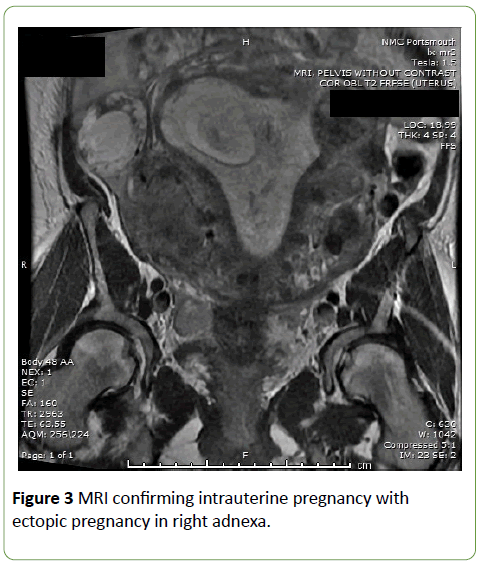Tracey H DeYoung1*, Julie R Whittington2 and Timothy E Sayles1
1Department of Obstetrics and Gynecology, Naval Medical Center Portsmouth, Portsmouth, VA, USA
2Department of Obstetrics and Gynecology, University of Arkansas for Medical Sciences, Little Rock, AR, USA
- *Corresponding Author:
- Tracey H DeYoung
Department of Obstetrics and Gynecology
Naval Medical Center Portsmouth
620 John Paul Jones Circle, USA
Tel: (757) 953-4300
E-mail: Tracey.h.deyoung.mil@mail.mil
Received date: July 13, 2017; Accepted date: August 11, 2017; Published date: August 16, 2017
Citation: DeYoung TH, Whittington JR, Sayles TE (2017) Heterotopic Pregnancy Presenting as Spontaneous Hemothorax. Gynecol Obstet Case Rep Vol.3:No.2:53. doi:10.21767/2471-8165.1000053
Introduction: Heterotopic pregnancy is rare, occurring in 1 in 30,000 spontaneously conceived pregnancies. Hemothorax as a presenting sign of ectopic pregnancy is also rare, with only a few case reports in the literature. We present a case of a spontaneous heterotopic pregnancy presenting as a hemothorax.
Case: A 36-year-old gravida 3 para 1 at 9 weeks 5 days by last menstrual period with reported twin intrauterine pregnancy presented with chest pain, shortness of breath, and syncope. A transabdominal ultrasound revealed an enlarged multi-fibroid uterus with an intrauterine pregnancy and a second ectopic pregnancy; however, it was unclear if this was located within the right cornua or adnexa. Given her severe shortness of breath, a computed tomography scan of the chest was completed which revealed a right pleural effusion. She additionally underwent pelvic magnetic resonance imaging for preoperative planning which confirmed a right adnexal ectopic pregnancy along with an intrauterine pregnancy. She had a right chest tube placed which evacuated 1700 mL of hemothorax. She underwent diagnostic laparoscopy followed by exploratory laparotomy with removal of the right fallopian tube and ovary.
Discussion: Heterotopic pregnancy may be rare, but must be considered even when a patient reports an intrauterine pregnancy. In the setting of acute blood loss of unexplained source, heterotopic must remain high on the differential. This patient’s complex anatomy and presentation with a hemothorax contributed to the difficulty in diagnosing the heterotopic pregnancy.
Keywords
Heterotopic pregnancy; Ectopic pregnancy; Hemothorax
Introduction
Heterotopic pregnancy is a rare, but life-threatening, event. It is defined as an extrauterine, or ectopic pregnancy, in conjunction with an intrauterine pregnancy. It is estimated to occur in 1 in 30,000 of spontaneously conceived pregnancies [1]. With the increasing prevalence of Artificial Reproductive Technology (ART), heterotopic pregnancy is becoming more common, occurring in approximately 0.09% pregnancies conceived through ART [2]. There have been case reports in the literature of ectopic pregnancies presenting as hemothorax; however, this is the first case report of a heterotopic pregnancy presenting as a hemothorax.
Case Report
A 36-year-old G3P1011 at 9 weeks and 5 days gestation, by sure LMP, with a reported dichorionic-diamnionic twin intrauterine pregnancy presented to the emergency room due to multiple syncopal episodes at home, with dyspnea and chest pain. She additionally had a 2-week history of lower abdominal pain, with intermittent vaginal spotting. She had known fibroid uterus with prior abdominal myomectomy and low transverse cesarean delivery. On arrival, she was tachycardic at 122 beats per minute, normotensive with blood pressure of 128/74, tachypneic with a respiratory rate of 22 and an oxygen saturation of 96%. She appeared uncomfortable and short of breath. Her exam was notable for coarse breath sounds on the right with diminished breath sounds at bilateral bases. Her abdomen was soft and nondistended, mildly tender to deep palpation in the central lower abdomen. She was anemic with a hemoglobin of 7.8 and had demand ischemia evidenced by an elevated troponin, which peaked at 0.071. She had an EKG which demonstrated sinus tachycardia with no ST segment changes. She reported a prior transvaginal ultrasound at an outside facility showing a twin intrauterine pregnancy, which was confirmed in her medical record. She was admitted to the internal medicine service for observation and trending of troponins.
Shortly after admission, an abdominal ultrasound was performed, revealing an 18.1 cm multifibroid uterus with a live intrauterine pregnancy with a fetal heart rate of 187, and a second ectopic pregnancy with a fetal heart rate of 182 (Figure 1). It was unclear by ultrasound if the ectopic pregnancy was located within the adnexa or the interstitial portion of the fallopian tube, raising concern for cornual pregnancy which may be more challenging to manage surgically. No free fluid was detected within the pelvis. She refused a transvaginal ultrasound due to significant right sided pain. Chest X-ray and chest CT showed a right sided pleural effusion with compressive atelectasis without evidence of pulmonary embolism (Figure 2). An echocardiogram revealed a normal ejection fraction. Pelvic magnetic resonance imaging was performed to further characterize the pregnancy location for operative planning, this confirmed the location of a right adnexal ectopic pregnancy. The uterus was noted to contain innumerable leiomyoma, and complex fluid was noted within the abdomen (Figure 3).
Figure 1:Abdominal ultrasound of heterotopic pregnancy.
Figure 2:CT scan showing right sided pleural effusion.
Figure 3:MRI confirming intrauterine pregnancy with ectopic pregnancy in right adnexa.
Prior to proceeding to the operating room, a right sided chest tube was placed to assist with intraoperative ventilation. This led to evacuation of 1600 milliliters of blood from the right hemi thorax. The patient was then taken to the operating room. Given that the patient was hemodynamically stable, a diagnostic laparoscopy was performed to quantify the amount of hemoperitoneum and assist with planning of the abdominal incision given her large fibroid uterus. 200 ml of blood and clot were present. Dense adhesions were present between the uterus and anterior abdominal wall, preventing visualization of bilateral adnexa. An exploratory laparotomy was performed through a midline vertical skin incision which extended from 3 cm above to 3 cm below the umbilicus. Due to the extensive adhesions between the right fallopian tube and ovary, salvage of the right ovary was not possible and a right salpingoophorectomy was performed. On inspection, the ectopic pregnancy was unable to be visually identified; however, it was palpated within the ampulla of the right fallopian tube. The specimen was sent to pathology for intraoperative confirmation of chorionic villi on frozen section. The contralateral tube and ovary were never identified secondary to the extensive adhesive disease and immobility of the enlarged leiomyomatous uterus. Estimated blood loss at the time of surgery was 1700 mL with total estimated blood loss of 3400 mL. She was transfused 4 units of packed red blood cells and 1 unit of fresh frozen plasma. Viability of intrauterine pregnancy was confirmed by ultrasound at conclusion of the case.
With minimal output following surgery, her chest tube was removed on post-operative day 2. She had no additional respiratory symptoms and recovered well post-operatively. However, on post-operative day 4, she had a spontaneous abortion of the remaining intrauterine pregnancy.
Discussion and Conclusion
This is a rare case of spontaneous hemothorax precipitated by hemoperitoneum secondary to a ruptured heterotopic pregnancy. Review of the literature reveals a few case reports of hemothorax associated with ectopic pregnancy. At least one of those cases occurred due to implantation on the diaphragm [3]. The others are hypothesized to have occurred secondary to communication through diaphragmatic pores and fenestrations [4-6]. Additional cases of spontaneous hemothorax secondary to hemoperitoneum are described in the literature [7]; one of which occurred after post-operative intraabdominal hemorrhage following laparoscopic hysterectomy [8]. This patient’s distorted anatomy due to her numerous fibroids made diagnosis of the heterotopic pregnancy quite difficult, especially with a prior reported ultrasound with a twin intrauterine pregnancy. This case represents a rare complication of ruptured heterotopic pregnancy, highlighting the importance of high clinical suspicion and timely treatment of both heterotopic and ectopic pregnancy.
References
- Hoffman BL (2016) Ectopic pregnancy. Williams Gynecology (3rd edn) McGraw-Hill Education: New York, NY, USA.
- Perkins KM, Boulet SL, Kissin DM, Jamieson DJ (2015) Risk of ectopic pregnancy associated with assisted reproductive technology in the United States, 2001-2011. Obstet Gynecol 125: 70-78.
- Fishman DA, Padilla LA, Joob A, Lurain JR (1998) Ectopic pregnancy causing hemothorax managed by thoracoscopy and actinomycin D. Obstet Gynecol 91: 837-838.
- Quinn AMS (2004) Ovarian ectopic pregnancy presenting with haemothorax. J Obstet Gynaecol 24: 840-841.
- Ganji H, Vidrine A (1970) Ectopic pregnancy presenting as hemothorax. Am J Surg 120: 807-809.
- Watson-Jones REV, Verco CJ (2015) Acute haemothorax after ruptured ectopic pregnancy. J Obstet Gynaecol 35: 655-656.
- Pratt JH, Shamblin WR (1968) Spontaneous hemothorax as a direct complication of hemoperitoneum. Ann Surg 167: 867-872.
- May J, Ades A (2013) Porous diaphragm syndrome: Haemothorax secondary to haemoperitoneum following laparoscopic hysterectomy. BMJ Case Reports 2013: bcr2013201088.




